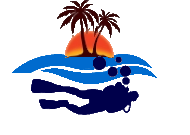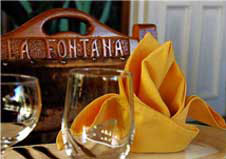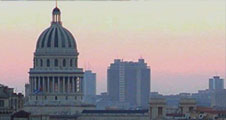Jamaica General Information
Jamaica. Introduction.
Jamaica, island nation, third-largest island of the Greater Antilles, situated south of Cuba in the northern Caribbean Sea. Jamaica has a maximum length, from east to west, of about 235 km (146 mi); the maximum width is around 80 km (50 mi). The total area of the nation is 10,991 sq km (4,244 sq mi). Kingston is the capital and largest city of Jamaica, and also a large commercial seaport.
Official Name - Jamaica
Capital - Kingston 538,100 (1995 metropolitan area)
Population - 2,505,000 (1996)
Life Expectancy - 71.4 years for men 75.8 years for women
Area - 10,991 sq km (4,244 sq mi)
Largest Cities - Spanish Town 110,400 Portmore 93,800
Languages - English; local patois
Religions - Christianity; Islam; Hinduism
Currency - Jamaican dollar
Government - Parliamentary democracy
Jamaica. History.
Arawaks from South America had settled in Jamaica prior to Christopher Columbus' first reached at the island in 1494. During Spain 's occupation of the island, starting in 1510, the Arawaks were exterminated by disease, slavery, and war. Spain brought the first African slaves to Jamaica in 1517. In 1655, British forces seized the island, and in 1670, Great Britain gained formal possession.
Sugar made Jamaica one of the most valuable possessions in the world for more than 150 years. The British Parliament abolished slavery as of August 1, 1834.Jamaica joined nine other U.K. territories in the West Indies Federation in 1958 but withdrew after Jamaican voters rejected membership in 1961. Jamaica gained freedom in 1962, remaining a member of the Commonwealth.
Historically, Jamaican emigration has been heavy. Since the United Kingdom limited emigration in 1967, the major flow has been to the United States and Canada . About 20,000 Jamaicans emigrate to the United States each year; another 200,000 visit annually. New York , Miami , Chicago , and Hartford are among the U.S. cities with a remarkable Jamaican population. Remittances from the expatriate communities in the United States , United Kingdom , and Canada , around at up to $800 million per year, make increasingly remarkable contributions to Jamaica 's economy.
Jamaica. Plants & Animals.
Jamaica has a high degree of biovariety. Three thousand species of plants grow on the island, and 27 % of them are found nowhere else on Earth. More than 200 species of flowering plants have been classified. Among indigenous trees are cedar, mahoe, mahogany, logwood, rosewood, ebony, palmetto palm, coconut palm, and pimento.Introduced varieties, such as the mango, breadfruit, banana, and plantain, also flourish on the island and are widely cultivated.The Jamaican animal life, as that of the West Indies generally, includes highly diversified bird life. Parrots, hummingbirds, cuckoos, and green todies.
Jamaica. Communications.
fully automatic domestic telephone network
domestic: NA
international: satellite earth stations - 2 Intelsat ( Atlantic Ocean ); 3 coaxial submarine cables
Jamaica.Culture.
Family life is central to most Jamaicans, although formal marriages are less prevalent there than in most other countries. It is common for three generations to share a home. Many women earn wages, particularly in households where men are absent, and grandmothers normally take charge of preschool children. Wealthier Jamaican families usually employ at least one domestic helper.
The main meal is almost always in the evening, because most people do not have time to prepare a midday meal and children normally eat at school. Some families eat together, but television has increasingly replaced conversation at the dinner table. The exception to this rule is Sunday, when tradition dictates that even poor families enjoy a large and sociable brunch or lunch, usually including chicken, fish, yams, fried plantains, and the ubiquitous rice and peas.
Jamaica. Defence.
Military branches: Jamaica Defense Force (includes Ground Forces, Coast Guard, and Air Wing), Jamaica Constabulary Force
Military manpower - military age: 18 years of age
Military manpower - availability: males age 15-49: 736,627 (2001 est.)
Military manpower - fit for military service: males age 15-49: 517,077 (2001 est.)
Military manpower - reaching military age annually: males: 27,729 (2001 est.)
Jamaica. International Disputes.
None
Jamaica. Economy.
The economy of Jamaica is primarily agricultural, but gains in mining, manufacturing, and tourism have diversified the economy. Annual budget figures for 1990-1991 showed about $600 million in revenues and $736 million in expenditures. In 1999 Jamaica ’s gross domestic product (GDP) was $6.89 billion, or about $2,650 per capita. In 1999, 6.5 billion kwh of electricity was produced.
Jamaica 's economy is mixed but increasingly based on services, notably tourism and finance. Since freedom in 1962, Jamaica has developed markedly but unevenly. The government controls some key industries, but there are many foreign-owned companies, particularly those controlling exports (bauxite and aluminum) and tourism, which are Jamaica 's main sources of foreign exchange. Mining and manufacturing became increasingly valuable to the economy in the latter part of the 20th century; the mining area has been highly vulnerable to fluctuations in the world market for aluminum. The island experienced a protracted recession in the 1990s after aluminum prices declined and many U.S. manufacturers relocated off the island.
Key sectors in this island economy are bauxite and tourism. Since assuming office in 1992, Prime Minister PATTERSON has eliminated most price controls, streamlined tax schedules, and privatized government enterprises. Continued tight monetary and fiscal policies have helped slow inflation - although inflationary pressures are mounting - and stabilize the exchange rate, but have resulted in the slowdown of economic growth .In 1996, GDP showed negative growth (-1.4%) and remained negative through 1999. Serious problems include: high interest rates; increased foreign competition; the weak financial condition of business in general resulting in receiverships or closures and downsizings of companies; the shift in investment portfolios to non-productive, short-term high yield instruments; a pressured, sometimes sliding, exchange rate; a widening merchandise trade deficit; and a growing internal debt for government bailouts to various ailing sectors of the economy, particularly the financial sector. Depressed economic conditions in 1999-2000 led to increased civil unrest, including a mounting crime rate. Jamaica 's medium-term prospects will depend upon encouraging investment in the productive sectors, maintaining a competitive exchange rate, stabilizing the labor environment, selling off reacquired firms, and implementing proper fiscal and monetary policies.
Jamaica. Education.
School attendance by children between the ages of 6 and 11 is nearly universal, and 70.9 % of all 12- to 18-year-olds attend secondary institutions. In 1996 the enrollment in primary schools was 293,900.
Jamaica. Government.
The 1962 constitution accomplished a parliamentary system based on the U.K. model. As chief of state, Queen Elizabeth II appoints a governor general, on the advice of the prime minister, as her representative in Jamaica . The governor general's role is largely ceremonial. administrator power is unconditional in the cabinet, led by the prime minister.
Parliament is composed of an appointed Senate and an elected House of Representatives. Thirteen Senators are nominated on the advice of the prime minister and eight on the advice of the leader of the opposition. General elections must be held within 5 years of the forming of a new government. The prime minister may ask the governor general to call elections sooner, however. The Senate may submit bills, and it also reviews legislation submitted by the House. It may not delay budget bills for more than 1 month or other bills for more than 7 months. The prime minister and the cabinet are selected from the Parliament. No fewer than two nor more than four members of the cabinet must be selected from the Senate.
The judiciary also is modeled on the U.K. system. The Court of Appeals is the highest appellate court in Jamaica . Under certain circumstances, cases may be appealed to the Privy Council of the United Kingdom . Jamaica 's parishes have elected councils that exercise limited powers of local government.
Jamaica.Languages.
English is the official language, although many Jamaicans speak a local dialect of English that incorporates African, Spanish, and French elements. Among the Christian majority, the Church of God , Baptists, Anglicans, Seventh-day Adventists, Pentecostalists, and Roman Catholics predominate. Several well-accomplished Jewish, Muslim, and Hindu communities exist.
Jamaica. Legal.
Legal system: based on English common law; has not accepted compulsory ICJ jurisdiction vote: 18 years of age; universal administrator branch: chief of state: Queen ELIZABETH II (since 6 February 1952), described by Governor General Sir Howard Felix COOKE (since 1 August 1991) head of government: Prime Minister Percival James PATTERSON (since 30 March 1992) and Deputy Prime Minister Seymour MULLINGS (since NA 1993) cabinet: Cabinet appointed by the governor general on the advice of the prime minister elections: none; the monarch is hereditary; governor general appointed by the monarch on the recommendation of the prime minister; prime minister and deputy prime minister appointed by the governor general Legislative branch: bicameral Parliament consists of the Senate (a 21-member body appointed by the governor general on the recommendations of the prime minister and the leader of the opposition; ruling party is allocated 13 seats, and the opposition is allocated eight seats) and the House of Representatives (60 seats; members are elected by popular vote to serve five-year terms) elections: last held 18 December 1997 (next to be held by March 2002) election results: % of vote by party - NA%; seats by party - PNP 50, JLP 10 Judicial branch: Supreme Court (judges appointed by the governor general on the advice of the prime minister); Court of Appeal
Jamaica.Life.
The population of Jamaica is primarily of African or mixed African-European origin, descended from slaves brought to the island between the 17th and 19th centuries. Among the accomplished minorities are East Indians, Europeans, and Chinese. About half the population lives in rural areas.
Jamaica. Organizations.
International organization Member
ACP, C, Caricom, CCC, CDB, ECLAC, FAO, G-15, G-19, G-77, IADB, IAEA, IBRD, ICAO, ICFTU, ICRM, IFAD, IFC, IFRCS, IHO (pending member), ILO, IMF, IMO, Intelsat, Interpol, IOC, IOM (observer), ISO, ITU, LAES, NAM, OAS, OPANAL, OPCW, UN, UN Security Council (temporary), UNCTAD, UNESCO, UNIDO, UPU, WFTU, WHO, WIPO, WMO, WToO, WTrO
Jamaica.People.
The population of Jamaica (2001 estimate) was 2,665,637, giving the nation an overall population density of 243 persons per sq km (628 per sq mi). The annual rate of population increase, formerly high, declined to 0.51 % by 2001. Emigration, primarily to the United States , Britain , and Latin America , has been substantial.
Population (2000): 2.66 million. Annual growth rate (2000): 0.6%. Ethnic groups: African 90.9%, East Indian 1.3%, Chinese 0.2%, White 0.2%, mixed 7.3%, other 0.1%. Religious affiliation: Anglican, Baptist and other Protestant, Roman Catholic, Rastafarian, Jewish. Languages: English, Patois. Education: Years compulsory--to age 14. Literacy (age 15 and over)--79.9%. Health (2000): Infant mortality rate--24.5/1,000. Life expectancy--female 75 yrs., male 70 yrs. Work force (2000, 1.1 million): Industry--17.8%; agriculture--21.4%; services--60.8%.
Jamaica.Politics.
Jamaica Labor Party or JLP [Edward SEAGA]; National Democratic Movement or NDM [Bruce GOLDING]; People's National Party or PNP [Percival James PATTERSON]
Jamaica.Provinces.
14 parishes; Clarendon, Hanover, Kingston, Manchester, Portland, Saint Andrew, Saint Ann, Saint Catherine, Saint Elizabeth, Saint James, Saint Mary, Saint Thomas, Trelawny, Westmoreland























